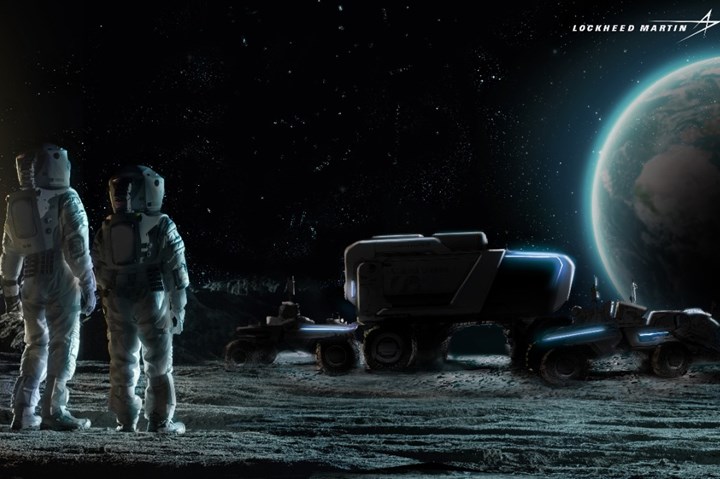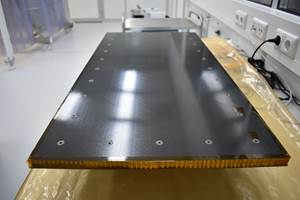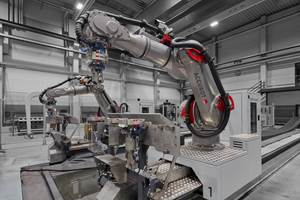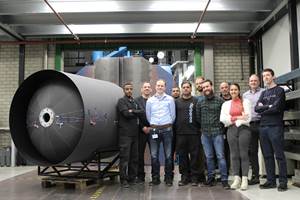Lockheed Martin, General Motors team up to further lunar exploration with autonomous moon rover design
The composite lunar rover concept will be well-equipped to travel farther distances for extended exploration and research capabilities.
Share

Photo Credit: Lockheed Martin.
With only 5% of the moon’s surface explored, Lockheed Martin (Bethesda, M.D., U.S.) and General Motors (GM, Detroit, Mich., U.S.) have teamed up to design the next generation of lunar rovers, capable of transporting astronauts across farther distances on the lunar surface. Unlike the Apollo days when the rovers only traveled four miles from the landing site, both companies note that NASA’s Artemis astronauts will go farther and explore more of the moon’s surface than ever before to conduct critical scientific research — to do this, they’re going to need some serious wheels.
Not only will these vehicles be well-equipped to go the distance, partners say, they will also be driver optional. Autonomous, self-driving systems would enable the vehicle to operate with or without humans onboard, and pave the way for future human missions, commercial payload services and enhanced scientific utility. Further, while vehicle design is still in its early stages, Lockheed Martin says, it’s reasonable to assume that the rovers will incorporate composite materials in some of its structures.
“These next-generation rover concepts will dramatically extend the exploration range of astronauts as they perform high-priority science investigation on the moon that will ultimately impact humanity’s understanding of our place in the solar system,” says Rick Ambrose, executive vice president, Lockheed Martin Space.
A Lockheed Martin-GM rover would be able to preposition itself autonomously near a landing site prior to the astronauts’ arrival, and astronauts would have the ability to task the rover from the Human Landing System (HLS) or the orbiting lunar Gateway to conduct science operations without a driver. This enables NASA to fit more science into a smaller amount of time, and will enable the world to uncover the critical information that the other 95% of the lunar surface may hold.
Zooming on the moon
Expertly outfitted to drive over rugged terrain in the dark and cold, the Lockheed Martin-GM rovers will be designed to survive and operate in the moon’s two-week long night that sees nighttime temperatures of -280ºF, and daytime temperatures of 260ºF.
“Autonomy will enable these rovers to carry tools and samples, and allow the crews to do more in the time they have there on the surface.”
“The biggest difference is, when you design for the moon and for space applications, the force of gravity is different and has to be taken into account,” says Madhu Raghavan, global research and development group manager at GM. “There are extreme temperature swings, and the radiation in space becomes a challenge in terms of systems design. You’re also operating in a vacuum and designing your systems to withstand the shock of the actual launch.”
Both partners contend that the vehicles’ design would mitigate these challenges. “We’ve led missions to other planetary bodies for decades, building spacecraft that can survive the high radiation environment, cold temperatures, and yet be very light and very reliable,” says Kirk Shireman, vice president, Lunar Exploration Campaigns at Lockheed Martin. “This is what we specialize in, and we are more than capable of meeting and exceeding this challenge for NASA.”
With both brains and brawn, the Lockheed Martin-GM alliance is said to bring together innovations from both companies to make transformative vehicles, drawing on strong legacies of engineering and performance from both companies. Lockheed Martin will lead the team by leveraging its legacy and history working with NASA.
“Our goal is to build a vehicle that is affordable, that exceeds our customer requirements, and to do it rapidly. Digital tools are how we achieve that,” Shireman says. “We’ve demonstrated already across programs and proposals the speed, affordability and reliability that digital tools enable, and we fully expect to leverage and expand on that experience with this program.”
GM brings to the table decades of experience designing for on- and off-road environments, a strong focus on quality and human safety and a shared mission.
“There’s a lot of synergy between our two companies — we complement each other well,” notes Jeff Ryder, vice president, Growth and Strategy at GM Defense. “The lunar rover designs for extreme off-road environments have a lot of similarities with our tactical military vehicles on the GM Defense side. It’s great to work with a company like Lockheed Martin who has a shared mission of supporting the warfighter.”
GM also brings to the table state-of-the-art battery-electric technologies and propulsion systems that are central to the company’s extensive electric vehicle strategy. Research from the development of battery and power systems for the lunar rover may ultimately spur advances on electric vehicles (EVs) as well, GM says.
“Because the operating conditions are so extreme in space, our work on this project will help us make safer and better batteries back on Earth,” Raghavan claims. “The moon and Mars are, of course, totally unstructured, unlined roads. Designing for that environment will ultimately just make our EV capabilities on Earth that much stronger.”
Enabling a celestial human future
So, what is NASA hoping to uncover on the uncharted territory that remains of the moon? The moon is often referred to as the cornerstone of the solar system. Scientific investigations on the Artemis program will help NASA understand the risks and potential resources of the moon’s South Pole, where they hope to establish the Artemis Base Camp concept by the end of the decade.
“The technology has evolved so much in the last 50 years, to the point where we can now use autonomy for these vehicles to aid in the astronauts’ missions,” Shireman says. “Autonomy will enable these rovers to carry tools and samples, and allow the crews to do more in the time they have there on the surface.”
To achieve the ultimate goal of using the moon’s resources to sustain a human presence, Shireman says we’ll need to have a reliable way of transporting those resources. This is the first major step in that direction.
“I’ve worked on many space programs in the past, but this isn’t just another space mission,” says Ryder. “It’s the return to, and permanent habitation of the moon. It’s not just cool or interesting — it’s historical. It’s a major milestone in human activity in space.”
Other scientific activities that surface mobility could enable include field geology, sample collection and return and deployed experiments. These investigations are conducted in the hopes that they may provide an increased understanding of how the moon formed and evolved, how it interacts with the sun, how water and other resources arrived at the moon and how they are transported and preserved.
“I always think about alliances, and how you have to start with something real,” Ryder says. “As we go do this, it’ll likely lead to additional opportunities. It’s a great pathway going forward, and I’m sure there will be more opportunities for our two companies to come together to further human spaceflight.”
Related Content
Nanomaterials optimize performance of space-ready carbon fiber composite panels
A recent ESA project led by Adamant Composites aimed to mature nanomaterial-enhanced CFRP for lighter weight, more thermally and electrically conductive materials for manufacturing satellite structures.
Read MoreAutomated robotic NDT enhances capabilities for composites
Kineco Kaman Composites India uses a bespoke Fill Accubot ultrasonic testing system to boost inspection efficiency and productivity.
Read MoreAirborne delivers composite upper stage tank for EU ENVOL project
Nine-member consortium targets development of low-cost, green vertical orbital launcher with manufacture of an ultra-lightweight composite tank design in an automated manufacturing environment.
Read MoreHyImpulse, Adamant Composites linerless CFRP tank passes hydrostatic burst test
The liquid oxygen (LOX) tank, to be used in a HyImpulse smallsat launch vehicle, demonstrates the ability to withstand pressures well beyond the limits of its intended use.
Read MoreRead Next
VIDEO: High-volume processing for fiberglass components
Cannon Ergos, a company specializing in high-ton presses and equipment for composites fabrication and plastics processing, displayed automotive and industrial components at CAMX 2024.
Read MoreAll-recycled, needle-punched nonwoven CFRP slashes carbon footprint of Formula 2 seat
Dallara and Tenowo collaborate to produce a race-ready Formula 2 seat using recycled carbon fiber, reducing CO2 emissions by 97.5% compared to virgin materials.
Read MorePlant tour: Daher Shap’in TechCenter and composites production plant, Saint-Aignan-de-Grandlieu, France
Co-located R&D and production advance OOA thermosets, thermoplastics, welding, recycling and digital technologies for faster processing and certification of lighter, more sustainable composites.
Read More





























